

|
Armadillo-70T (Raspberry Pi) Released

The Armadillo-70T is a complete Linux based computer module with built-in 800x480 resolution TFT LCD display. The board is designed to be a Raspberry Pi with built-in display, and features the same Broadcom BCM2835 System-On-Chip (SoC) which is found on the Pi.
|
2016/01/25 |


|
RF Meter click Released

RF Meter click is a radio frequency power measurement device covering a frequency span from 1 MHz to 8 GHz over a 60 dB range (approximately). It enables monitoring and measuring frequency levels to ensure proper functioning and leak detection. An external antenna acquires the signal, which is then processed by the AD8318 logarithmic detector. The resulting voltage is fed into an MCP3201 ADC. For communicating with the target board MCU, the mikroBUS SPI interface is used (CS, SCK, MISO pins), with additional TEMP OUT pin.
|
2016/01/25 |

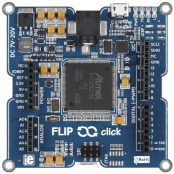
|
Flip & click (Arduino) - Now in Stock!

The Arduino-compatible "Flip & click" is now in stock!
|
2016/01/25 |


|
RTC6 click Released

RTC6 click carries Microchip's MCP79410 Real-Time Clock/Calendar IC with built-in 64 bytes of battery-backed SRAM an additional 1 Kbit of EEPROM. 64 bits of protected EEPROM requires an unlock sequence to be unlocked, which makes it suitable for storing a unique ID or other critical information. RTC6 click tracks hours, minutes, seconds, days, months, years and weekdays, with leap year compensation until the year 2399. The clock frequency is derived from an onboard 32.768KHz crystal oscillator. Backup power is supplied by a coin-cell Lithium battery. RTC6 communicates with the target board MCU through the mikroBUS I2C interface (SCL, SDA) along with a multifunction pin (MFP, in place of default mikroBUS INT pin). The multifunctional pin (MFP) can be configured as an alarm, a square wave frequency output, or a general purpose output. The board is designed to use either a 3.3V or a 5V power supply.
|
2016/01/19 |

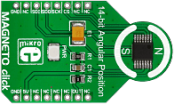
|
Magneto click Released

Magneto click carries an AS5048A contactless magnetic angle position sensor. The sensing circuitry relies on the Hall Effect to detect the vector of a nearby magnetic field in a 360° two-dimensional plane parallel to the surface of the chip. AS5048A delivers precise angle measurements down to 0.05° in 14-bit resolution. Its accuracy is not impeded (up to a point) by misalignment, air gap variations, temperature variations, even stray magnetic fields. The PWM outputs the absolute position information. Additionally, the magnet's zero position is programmable (via SPI). Magneto click communicates with the target MCU through the mikroBUS SPI interface (CS, CLK, MISO, MOSI). Designed to use a 5V power supply.
|
2016/01/19 |

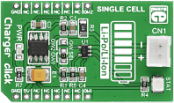
|
Charger click Released

Charger click carries both a battery charger controller and a battery charge monitor, along with a battery connector. The smaller chip is MCP73831, a miniature single-cell Li-Ion and Li-Polymer charge management controller with a programmable charge current from 15 to 250 mA. The larger IC is DS2438, a smart battery monitor which integrates a temperature sensor, a timer, an ADC to measure the battery voltage and current, and a current accumulator that monitors the total amount of current going into and out of the battery. Charger click communicates with the target MCU through a 1-Wire interface. Charger click is designed to use a 5V power supply.
|
2016/01/19 |

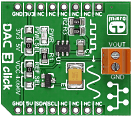
|
DAC3 click Released

DAC3 click carries Microchip's MCP4726 IC, a 12-bit digital-to-analog converter, along with voltage output screw terminals. The digital value is converted to the appropriate voltage level in the range between GND and REFERENCE (VCC or 4.096V), which is proportional to the received 12-bit number. MCP4726 also integrates EEPROM for storing DAC register and configuration bit values. The board communicates with the target board MCU through the mikroBUS I2C interface (SCL, SDA pins). Standard (100 kHz), fast (400 kHz) and highspeed (3.4 MHz) I2C modes are available. Uses either a 3.3V or a 5V power supply.
|
2016/01/19 |

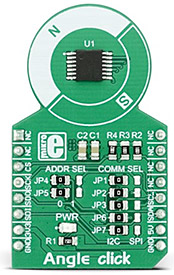
|
Angle click Released

Angle click is a precise Hall-effect angle sensing click board that can be used to measure the rotational angle of the magnetic field in the X-Y plane above it (parallel to the surface of the click), through the whole range of 360°. The click yields very precise results for both off-axis and axis operation, which make it a perfect choice for precise measuring of the rotational angle in a wide range of different high-speed applications, for example in the automotive industry: electronic power steering, transmission, torsion bar, or the motor shaft rotation.
Angle click features the A1335 Hall-effect angle sensing IC, made by Allegro MicroSystems LLC. This IC measures the magnetic field angular vector, based on the actual physical reading of the integrated Hall-effect sensor, as well as the user selected parameters, such as the digital filtering, dynamic range and scaling. The integrated 32bit MCU ensures that the processed data is delivered with a minimal delay and it has enough power to provide the complex processing of the input values so that the measurement remains fast, precise and linear.
|
2016/01/12 |

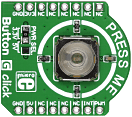
|
Button G click Released

Button G click is the simplest solution for adding a single pushbutton to your design. The button itself is transparent, 6.8mm in diameter and has a green LED backlight. When pressed, it sends an interrupt signal to the target board microcontroller. The backlight LED is controlled separately through the mikroBUS PWM pin, so you can program all kinds of patterns (varying level of light intensity or rate of blinking on subsequent button presses). The board can use either a 3.3V or a 5V power supply.
|
2016/01/12 |

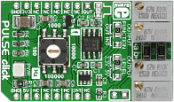
|
PULSE click Released

PULSE click is a pulse generator with an adjustable frequency. It carries the NE555 precision timer capable of producing highly accurate time delays. The frequency of PULSE click is configured in two steps. First select between four frequency bands by using the frequency selector - a circular central switch in the middle of the board. Starting from the six-o-clock position and moving counter-clockwise in quarters, it has 4 options: 0) Up to 100 Hz; 1) Up to 1 kHz; 2) Up to 10 kHz; and 3) Up to 100 kHz. After you select the appropriate position, use the onboard potentiometer to fine-tune the desired output frequency. The resulting output can be configured either as a digital output (communicating with the MCU through the mikroBUS OUT pin) or an interrupt (INT pin). The board is designed to use either a 3.3V or a 5V power supply.
|
2016/01/04 |


|
EEPROM 3 click Released

EEPROM3 click carries Atmel's AT24CM02 DIP-8 socket EEPROM chip with 256 KB of memory. The chip has byte and page write speeds equal or less than 10 ms. It's specified for a million write cycles, with 100 years of data retention. The memory, organized as 262144 x 8 bits. The board communicates with the target board MCU through the mikroBUS I2C interface (SCL, SDA pins) with speeds up to 1 MHz. An onboard jumper allows you to select the device address (two of them can be connected on the same I2C bus, for a total of 512 KB). The board is designed to use either a 3.3V or a 5V power supply.
|
2016/01/04 |


|
LoRa click Released

LoRa RF click carries Microchip's RN2483 fully certified LoRa Sub-GHz, 433/868 MHz European R&TTE Directive Assessed Radio Modem. Two antenna connectors allow you to choose which of the two frequency bands will be employed.
The RN2483 module has a specified range of >15km in rural and suburban settings, and >5km coverage in urban areas.
A LoRaWAN Class A protocol stack is embedded (bidirectional end devices), as well as an ASCII command interface accessible through UART. The high receiver sensitivity can go down to -148 dBm.
LoRa RF click communicates with the target board MCU through the mikroBUS UART interface (CTS, TXD, RXD), with the addition of a Reset pin (RST). The board is designed to use either a 3.3V or a 5V power supply.
|
2015/12/22 |


|
Touchpad click (Capacitive) Released

Touchpad click is a capacitive touch input device driven by Microchip's low-powered MTCH6102 controller. The touchpad surface is covered with a sheet of black plastic to demonstrate the chip's support for cover layers (up to 3mm for plastic, 5mm for glass) Touchpad click communicates with the target MCU through the mikroBUS I2C interface (SCL and SDA pins), with additional functionality provided by the Interrupt and RSTL pins. Designed to use a 3.3V power supply.
|
2015/12/11 |

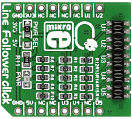
|
Line Follower click Released

Line Follower click carries an array of five QRE1113 miniature reflective object sensors. As the name implies, Line Follower click is best used for line following robots and cars. Each one of the QRE1113 sensors consist of an infrared transmitter and infrared receiver. For communicating with the target MCU, the individual sensors have their own separate digital outputs, each one routed through a single mikroBUS pin: OUT1, OUT2, OUT3, OUT4 and OUT5 (in place of default mikroBUS pins RST, AN, PWM, TX and RX, respectively). Line Follower click is designed to use either a 3.3V or a 5V power supply.
|
2015/12/10 |

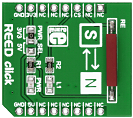
|
REED click Released

REED click is a simple board that carries a standard (Single Pole Single Throw Normally Open) reed switch. A reed switch comprises of two thin magnetic contacts sealed inside a casing. One contact is a magnetic north pole, the other a south. The two contacts are separate, until a magnetic field is applied which snaps them close, activating the switch. A single mikroBUS pin (CS) connected to the MCU outputting a 1 or 0 depending on the whether the switch is close or open. REED click is designed to use either a 3.3V or a 5V power supply.
|
2015/12/09 |


|
XBee click Released

XBee click carries the Xbee and Zigbee-compliant XB24CZ7PIS-004 module with a PCB antenna from Digi International. The module provides wireless connectivity to end-point devices in ZigBee mesh networks. The module has a wireless range of up to 60 meters indoors, or up to 1200m in outdoor line-of-sight applications. The RF data rate is up to 250,000 Kbps. The board can communicate with the target MCU either through the mikroBUS UART interface (TX, RX, RTS i CTS), or SPI (MISO, MOSI, SCK, CS). Additional functionality is provided by Reset, and ATTN-DTR pins. To simplify deployment, the click board features a pushbutton to issue simple configuration commands with subsequent button presses. Uses 3.3V power supply only.
|
2015/11/30 |


|
Haptic click Released

Haptic click carries DRV2605, a Haptic Driver for ERM and LRA vibration motors (acronyms stand for Eccentric Rotating Mass and Linear Resonant Actuator, respectively). The DRV2605 IC integrates an extensive library with over 100 haptic effects. These include audio-to-vibe features, which generate vibrations from the lower frequency range of the audio input (licensed version of ToushSense 2200 effects from Immersion). The board also carries screw terminals for connecting said motors, as well as an audio interface (3.5mm jack). Haptic click communicates with the target MCU through mikroBUS I2C (SCL, SDA), EN (in place of CS) and PWM pins. The board is designed to use either a 3.3V or 5V power supply.
|
2015/11/26 |


|
Wire Jumpers - Box with 140 pcs Released

Instead of keeping your wire jumpers jumbled up like a bowl of spaghetti, consider this pack of 140 wire jumpers in a nifty box for easy storage. 14 different lenghts of 22AWG wire all cut, stripped and pre-bent, 10 pieces of each of the following length: 2, 5, 7, 10, 12, 15, 17, 20, 22, 25, 50, 75, 100, and 125mm. A bigger box with 350 pieces is also available.
|
2015/11/25 |

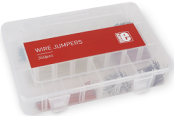
|
Wire Jumpers - Box with 350 pcs Released

Instead of keeping your wire jumpers jumbled up like a bowl of spaghetti, consider this pack of 350 wire jumpers in a nifty box for easy storage. 14 different lenghts of 22AWG wire all cut, stripped and pre-bent, 25 pieces of each of the following length: 2, 5, 7, 10, 12, 15, 17, 20, 22, 25, 50, 75, 100, and 125mm. A more compact box with 140 pieces is also available.
|
2015/11/25 |

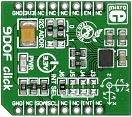
|
9DOF click (Accel, Gyro, Mag) Released

9DOF click carries ST's LSM9DS1 inertial measurement module that combines a 3D accelerometer, a 3D gyroscope and a 3D magnetometer into a single device outputting so called nine degrees of freedom data (3-axis acceleration, angular velocity and heading), in 16-bit resolution. 9DOF click communicates with the target MCU through the mikroBUS I2C interface (SCL and SDA) with additional functionality provided by the programmable Interrupt (INT) pin, as well as the Enable (EN) pin. The IC has multiple interrupt lines which can be accessed through jumpers on the click board. I2C addresses are specified in the same manner. The board uses a 3.3 power supply only.
|
2015/11/23 |

|

